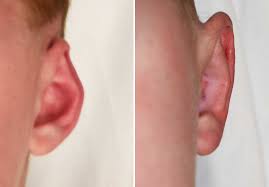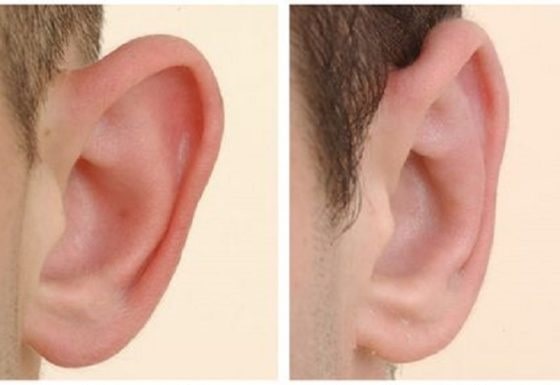Otoplasty surgery (ear surgery)
In this day and age, the number of people undergoing cosmetic surgeries have considerably increased. People can now easily change whatever feature in their faces or bodies that they do not like or feel secure about. In the past, cosmetic surgeries used to leave a scar mark. However, nowadays cosmetic surgeries leave no trace at all due to the development of surgical techniques and equipment. People resort to plastic surgeries to improve their features, fix their defects, and have better appearances.
One of the features that some people would like to change is the protruding ears. The natural shape of the ear is when the cartilage of the ear is almost stick to the head. However, When the cartilage of the ear is protruded away from the head, this might become a source of discomfort and psychological issues.
Children with prominent ears suffer from bullying at school, and adults hide their ears with their hair because they feel embarrassed. For this reason, people with prominent ears resort to plastic surgeries to get rid of this disturbing burden.
If you consider having an otoplasty surgery, we recommend you have it in Iran. Iran is by far the best country for a surgery whether it is a medical or plastic surgery, and Iranian surgeons are well experienced, professional, and highly qualified. They perform all kinds of surgeries with reasonable costs. Please continue reading to know more about otoplasty in Iran with Dr. Saeedi, the proficient ENT surgeon in Tehran.
What is otoplasty surgery?
Otoplasty is a surgical procedure that aims at enhancing the shape, place or proportion of the ear with the head.

What are the reasons behind a prominent ear?
A prominent ear could occur due to birth defects or the irregular growth to one or both ears.
What makes a good candidate for otoplasty?
In order to be a good candidate for otoplasty, you must have one of the following things:
- Macrotia: oddly big ears.
- Asymmetric ears.
- Ear deformities.
- Ears with different sizes or shapes.
- Prominent ears.
- Oddly small ears.
The patient should be older than 5 years to make sure that the ears grow naturally after otoplasty surgery.
Otoplasty surgical and nonsurgical techniques
The classical method
It is performed by making an incision in the pinna to reach the ear cartilage. After that, the cartilage is removed or bent in order to form a new shape and size according to the patient’s desire. Eventually, the extra skin is removed and the wound is sutured and covered with a bandage.
What distinguishes this method is that it is easy to reach the back of the ear and that the scars are barely visible after the surgery.
Nonsurgical otoplasty method for babies
Babies, who are no more than 6 months old, have fragile cartilages. Therefore, it is better to correct their ear cartilages when they are weak by a nonsurgical technique than have it corrected by a surgery later on. It is done by having the baby wear an ear mask to correct and control the growth of the ear cartilage.
The earfold method
An implant made from nitinol is used for pinning the ear cartilage. This technique requires a tiny incision in the skin that is about 5mm. The person can see the results before the operation in a device called pre-fold device. The results are fast and permanent, and the costs are lower than the traditional method while the scars are barely observed. This method requires a small ear bandage.
Preparing for the operation
Some steps and test must be done before otoplasty. These can include:
- Do not eat or drink from the night before the operation.
- Wear a comfortable shirt that is easy to take off without harming the ears in the day of surgery.
- Avoid taking blood thinners.
- Inform the doctor about any medication that you are on.
- Quit smoking before the operation because it slows down the healing process.
- Bring a companion with you when you come to the hospital.
How is otoplasty surgery performed?
Otoplasty involves several steps as explained here.
Otoplasty surgery steps
- Step one, Anesthesia: The surgery is performed under general or regional anesthesia according to the patient’s case and the doctor’s opinion.
- Step two, surgical incisions: The doctor resorts to surgical techniques to fold the pinna to reduce the size of the ear cartilage. The incisions are usually made in the back of the ear. However, sometimes it is necessary to make the incision in the front of the ear. In this case, the doctor tries to hide the scar within the folds of the ear.
- Step three, suturing the incisions: the doctor sutures the wound to provide the new shape of the ear.
After otoplasty surgery
Adults are permitted to return home after the operation. However, it is best for children to spend the night in the hospital to check on them and make sure everything is fine.

The recovery period is about 7 days after otoplasty surgery, during which you have to follow some instructions, including:
- Avoid heavy duties.
- Try not to wet your ears during the shower.
- Keep the wound clean and sanitized.
- Call the doctor in cases of bleeding or fever.
- It is permissible to travel by car or plane since it does not affect the wound.
- Do not apply pressure on the ears.
- Do not wear earrings or glasses during the first three months after the surgery.
As for otoplasty pain, it can be reduced by painkillers prescribed by the doctor.
Otoplasty risks and benefits
Otoplasty risks
Otoplasty surgery is normally a simple low-risk procedure. However, like any other surgical procedure, otoplasty surgery is accompanied by some complications such as:
- Allergies
- Infections
- Bruises
- Disorders
- Otoplasty failure
- Disturbance in the healing process
These complications can be avoided by resorting to a well-experienced surgeon.
Otoplasty benefits
The main advantages of otoplasty include:
- Otoplasty corrects the shape and size of the ears.
- Increases the person’s confidence level.
Why to undergo an otoplasty in Iran with Dr. Saeedi?
Iran is well known for being an excellent country in health services, whether medical or cosmetic, and many Iranian surgeons are famous all over the world. Likewise, the low cost of performing surgeries in Iran makes it a popular destination for many people who want to have cost-effective and high-quality surgeries.
Dr. Masoumeh Saeedi is among the distinguished Iranian surgeons. She is a board certified specialist and has a fellowship in otolaryngology since more than 15 years ago. Since then she has performed more than 5,000 successful surgeries including otoplasty for Iranian and international patients visiting Iran.
Because of her distinction, Dr. Saeedi was able to become an Associate Professor of Otolaryngology at Baqiyat Allah University for Medical Sciences in Tehran at the age of 33 years only, and this makes her keep up with the latest scientific research in her specialty.
Since technologies are always developing in the medical field, Dr. Saeedi is always keen to update her information and technology. For this reason, she has undergone many specialized courses in medically advanced countries such as France, Germany, South Korea, Portugal, Malaysia and Poland among others.
By choosing to undergo otoplasty in Iran with Dr. Saeedi, you guarantee that you will get the best results from the operation due to the high experience of the doctor and because it is preferable to have this surgery done by an ENT specialist surgeon.
Just contact us now to get a free consultation on otoplasty in Iran with Dr. Saeedi.
Cost of otoplasty in Iran with Dr. Saeedi
Since otoplasty is a plastic surgery, its costs are not covered by insurance companies. Therefore, the cost is a prominent factor in determining where to undergo the surgery.
The typical cost of otoplasty surgery is around $4,000 in USA and about $5,000 in UK, while it costs only a fraction of this sum in Iran, meaning that you pay less and have the surgery done by a highly qualified surgeon if you choose to undergo otoplasty in Iran with Dr. Saeedi.
Please contact us now to get a free consultation and price quote on otoplasty in Iran with Dr. Saeedi.
Frequently asked questions about otoplasty:
Can otoplasty make ears smaller?
Yes, it can. Otoplasty is the surgical procedure that corrects the shape of the external ear. It fixes large ears, small ears and prominent ears.
Can otoplasty be reversed?
Yes, it can be reversed. A reverse otoplasty or over-correction is a procedure to undo the complications of a primary otoplasty.
Can you have otoplasty twice?
Sometimes otoplasty surgery fails, which means that the patient needs to undergo another otoplasty.
Does otoplasty last forever?
Yes, successful otoplasty surgeries last forever
Does otoplasty affect hearing?
No, it does not affect hearing. Otoplasty is a plastic surgery. It corrects the shape of the ear. It has nothing to do with the function. It is not for medical purposes.
Does otoplasty leave scars?
Traditional otoplasty surgeries used to leave scars. However, the scars of new otoplasty methods are minimal and usually in the fold of the ear.
Does otoplasty surgery hurt?
All surgical procedures are somehow painful. However, the degree of pain differs from one surgery to another. Otoplasty is a simple surgery that is accompanied by a light degree of pain.
Is otoplasty safe?
Otoplasty is a safe surgery. For the best results of otoplasty surgery, one must go to a professional surgeon.
Is otoplasty worth it?
Yes, it is worth it. It gives the person a feeling of increased self-confidence.
Who performs otoplasty?
ENT surgeons are the best ones to perform otoplasty. Iranian ENT surgeons are well-experienced and professional. They perform successful surgeries.

